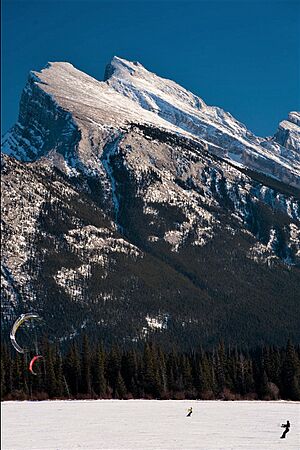Snowkiting facts for kids

Snowkiting (also called kite skiing) is an exciting winter sport. People use a large kite to glide over snow or ice. It's a lot like kiteboarding on water, but you use skis or a snowboard instead. The kite helps you move and even jump high into the air!
Snowkiting is special because you can travel uphill or downhill, no matter which way the wind blows. It's becoming very popular in snowy places like Russia, Canada, Norway, and the United States. Adventurers use kites to travel long distances. Other riders focus on cool tricks, big jumps, or racing fast.
How to Snowkite
Snowkiting uses skills similar to windsurfing. You control the kite with your hands and arms. This means your arms are busy, so balancing can be a bit tricky at first. But the kite also pulls you forward and up, which helps you stay steady.
Snowkiting Gear
Special equipment helps snowkiters have the best experience.
- Skis: Skis for snowkiting are usually about 215 cm long.
- Snowboards: Snowkiteboards are often around 200 cm long. Newer snowboards, called reverse camber snowboards, make it easier to steer and control your direction.
- Bindings: Some snowkiters use special rotational snowboard bindings. These fit between your boot and the board. They help reduce stress on your ankles and knees while you ride.
Where to Snowkite
You can snowkite in many places, as long as there is enough wind. You don't always need a steep hill. You can even ride on flat ground or go uphill if the wind is strong enough.
It can be harder to snowkite on very steep slopes. The top of a hill might block the wind or make it gusty. This can make your kite behave strangely or even fall. So, wide-open, snowy areas are often the best spots for snowkiting.



